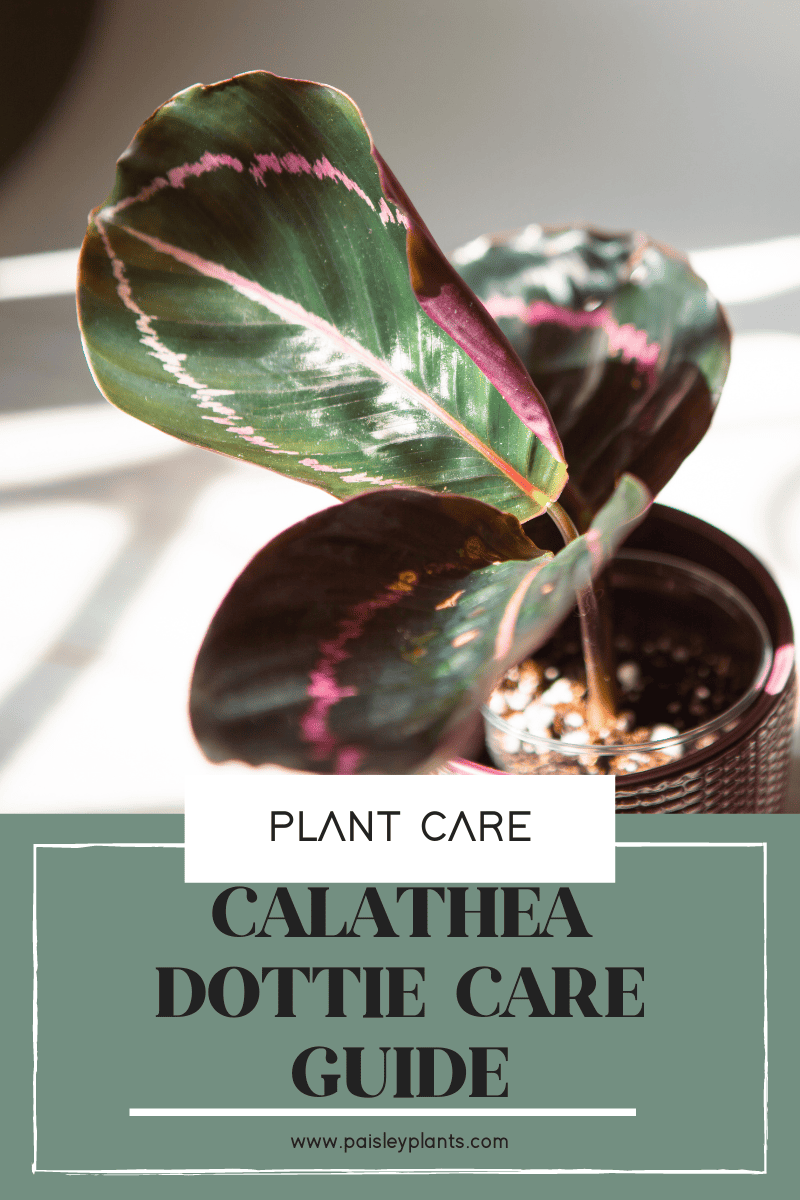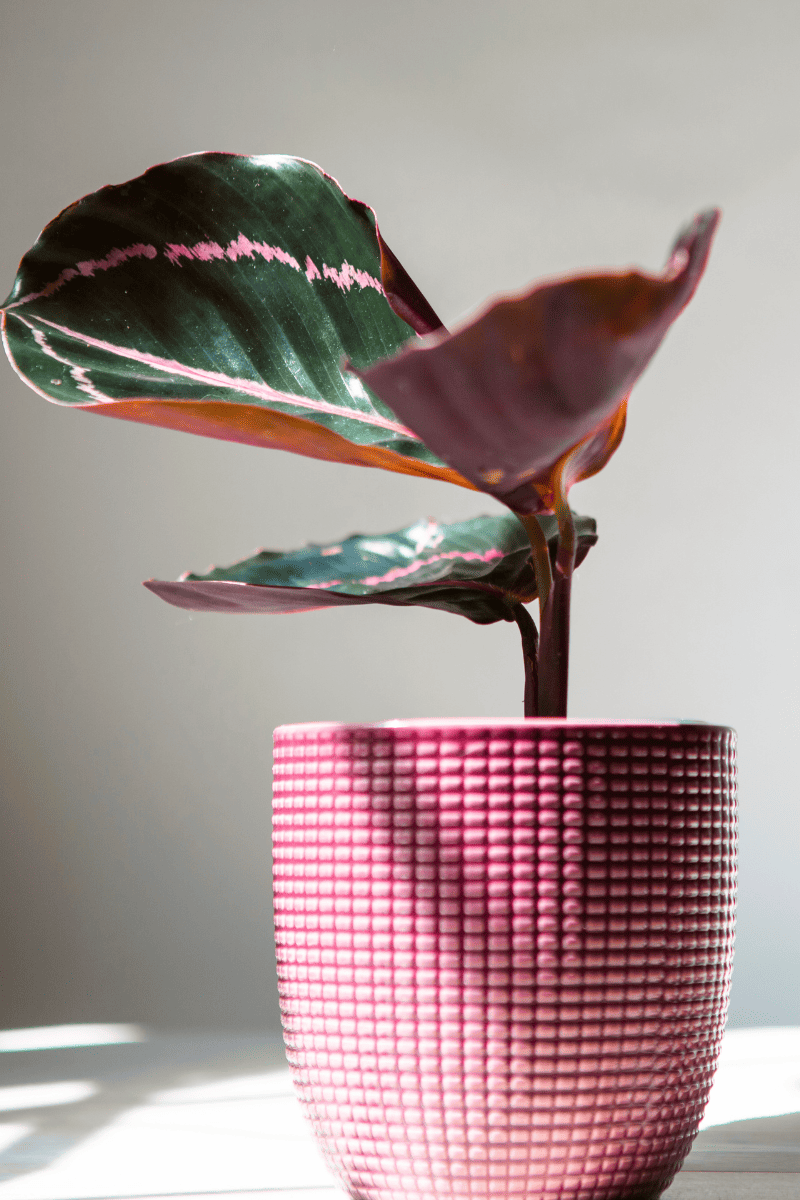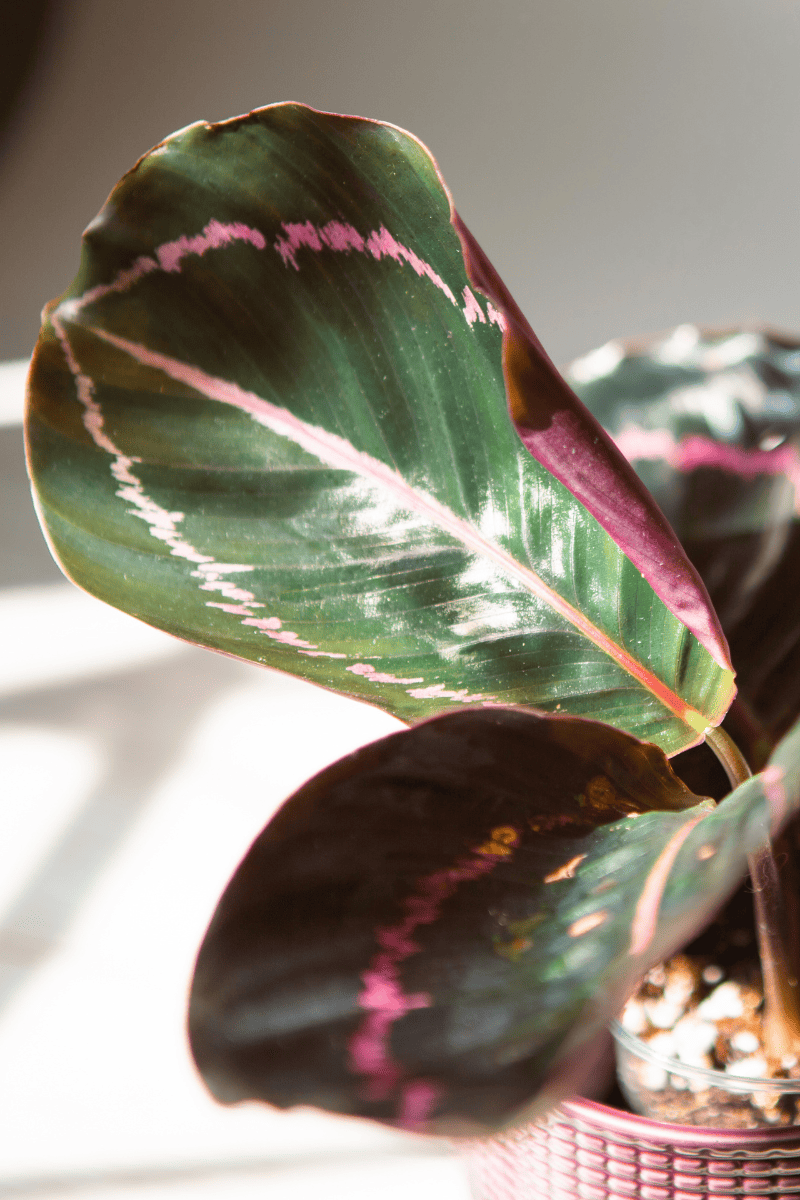The Calathea Dottie is a plant that you could say is an example of the simple and the stunning at the same time!
It has intensely contrasting color patterns with very dark leaves (almost black!) and bright hot pink colored patterns that run along the leaf rib and around the leaf perimeter.
One bad thing about it, though, is that they are a bit fussy and sometimes a bit high maintenance when it comes to their care. Because of their fussiness, they can’t be ignored for long! They are so beautiful, they will get your attention over and over again! They are gorgeous!

This post includes affiliate links.
Table of Contents
Calathea Dottie Background
The calathea species in general come from the tropical Americas – both Central and South America. The Calathea Dottie is actually under a patent developed by Anne E. Lamb who created the plant in Florida in 1998.
She first filed the patent though in the year 2000. She used a tissue culture from Calathea roseopicta to create the Calathea Dottie.
In addition to Calathea Dottie, this plant also goes by the common names Calathea Roseopicta Dottie, Rose Painted Calathea, Calathea ‘Black Rose’. Like all Calathea plants, these plants are considered prayer plants. They’re called this because of the way their leaves curl up together like praying hands in the evening time.
Toxicity
The one good thing about these plants is that they are not toxic to either humans or pets! You can have them in your home even if you have young children or pets, but you should always take care to not leave them where either a child or a pet could ingest the leaves or the soil of any plant.
Calathea Dottie Care Guide

Water
Because this beautiful plant is originally from a tropical area, it will require sufficient moisture. Water when the top 25% of the soil is dry. The soil should be kept evenly moist, but not soaking wet. Good drainage is necessary to allow excess water out and to avoid root rot.
These plants are very sensitive to the water you use to water them. They love low mineral, soft acid water between 5.5 and 6.0 PH. Hard water high in minerals and salts will leave with brown leaf tips. You should use filtered water, distilled water, or rain water on these plants to prevent mineral buildup.
Light
Calathea Dotties grown as an indoor plant require plenty of indirect sunlight. Direct sunlight will cause the decorative leaves to fade and lose their beautiful markings. They can tolerate some shade, but the more indirect light, the better the foliage will look.
You can expect that your plant will do best if you have it in a place with medium to bright indirect light. This will be the best condition for your plant, but it can also tolerate low indirect light for a limited amount of time.
Soil
The best soil for your Calathea Dottie is a light well draining one. A mix of potting soil, perlite and peat will keep the roots from rotting, providing you don’t overwater your plant. Be sure to not use a heavy soil or clay type mix for these plants.
Keeping the soil moderately moist will ensure that the roots don’t stand in water for any length of time. Using the right kind of soil can help allow the water to drain properly out the drainage holes in the bottom of the pot.

Fertilizer
The Dottie has an average growth rate and since it isn’t a particularly prolific grower, you may be able to encourage new growth with fertilizer. Giving your plant a boost with some diluted liquid fertilizer is a good way to keep your plant healthy and happy. You can do this during the growing season (spring and summer months) but stop during their dormant period (fall and winter months).
These plants are susceptible to fertilizer burn, however, so you need to be careful when fertilizing. If you see brown spots on the leaves, this may indicate fertilizer burn.
You can remedy this by setting the plant under a faucet of water and letting the water run on the plant for 10 minutes or so. Allow the pot to completely drain. Discontinue fertilizing until the plant recovers.
Temperature and Humidity
The optimal temperatures for your Calathea Dottie are 65 to 75 degrees F. They are sensitive to cold drafts from windows and doors. In the winter, beware of heat vents blowing on the plant leaves. They cannot tolerate uneven heating or drying vents or drafts.
They are happy at 50% to 60% humidity, although they can tolerate high humidity levels. Don’t let the humidity drop below 40%, however.
Frequent misting of your Dottie will help mimic a humid environment if all else fails. You can also place your tropical plant in a bathroom or a kitchen where there tends to be high levels of humidity. Keep an eye on your plants, though, to avoid being hosts for bacteria and fungi!
Pests and Diseases
Even though most plants tend to get attacked by pests, you can take steps to avoid them. Dotties are especially susceptible to spider mites. They are the biggest problem for Dotties.
Watch for the webs. Treat immediately with insecticidal soap or Neem oil and continue for two weeks or more to remove the next generation of spider mites after the adults die off. Eggs attach to the leaves and cannot be washed off easily.
Fungus gnats, mealy bugs, scale, thrips, and whiteflies are also common to houseplants and they are no exception for the Calatheas. Working towards good watering, light, and humidity care will go a long way to preventing these types of pests and diseases.
Pruning and Repotting
For pruning your Calathea Dottie plants, you should always use a sterile hand pruner or sharp scissor. This will give a clean cut that will heal quickly. Pruning is usually done to shape the plant or cut off unsightly leaves.
Calatheas will grow wider rather than taller with time. It is also recommended that you wash the leaves of the plant occasionally to keep the leaf pores open for plant respiration. They get their oxygen from the air and this helps stimulate their growth!
Your Dottie will require repotting when the roots begin growing out of the drainage hole in the bottom of the pot. This will usually happen every one to two years. When you are ready to repot your plant, find a new pot that is between one to two inches larger than the current one.
Calatheas tend to grow wider than taller. They grow from rhizomes and they grow new offshoots to the sides of the mother plant. This means they will fill out the pot as a wider plant eventually. They do not like to be overly rootbound.
If you want to encourage faster growth, choose a pot that is about two inches wider in diameter than the current pot. Also, use a well draining ceramic or plastic pot with very good drainage. Terra cotta pots are NOT recommended for Calatheas since they will wick too much water away from the soil.
Common Problems
If the leaves of your Dottie begin to curl up, the plant droops or the leaf edges turn brown, suspect watering problems. Also, underwatering can show all the same symptoms. Adjust your watering schedule or soil mix to try to accommodate these problems.
Yellow leaves can also mean the plant’s roots are too saturated and are starting to die. For the best results, try watering the soil once a week to see if this works. Alternately, don’t let the soil dry out completely as they prefer moist soil. Keeping the humidity at the proper level will also go a long way to helping solve common problems for your plant.
Where to Buy
FAQs
Most Calatheas flourish in humid conditions, so this would be a great room to keep your Dottie in! And since it enjoys moderate, indirect light, you don’t have to worry about how small your bathroom window is or whether it’s placed too far away from it!
However you water your Calathea, just be sure it leaks out the bottom of the drainage holes. You can use the bottom watering technique, but also remember that you should use filtered or rain water since they are very sensitive to the chemicals in normal tap water.
Yes, you should cut them off. The brown sections of the leaf will never turn green again and are just a drain on your Calathea’s energy. If one of the leaves has large sections of brown on it, just cut the entire leaf off with a sharp pair of sterile scissors.
In Conclusion
So, now that we’ve learned a little bit about the Calathea Dottie, what do you think? Is it something you’d like to buy and give it a try?
I really do think if you give some thought to it and be intentional about the care you give it, you should be a successful Calathea Dottie parent! As always, keep on growing!
Love Calathea plants? Check out the Calathea White Fusion here!
